8 Fun Yoga Poses for Toddlers
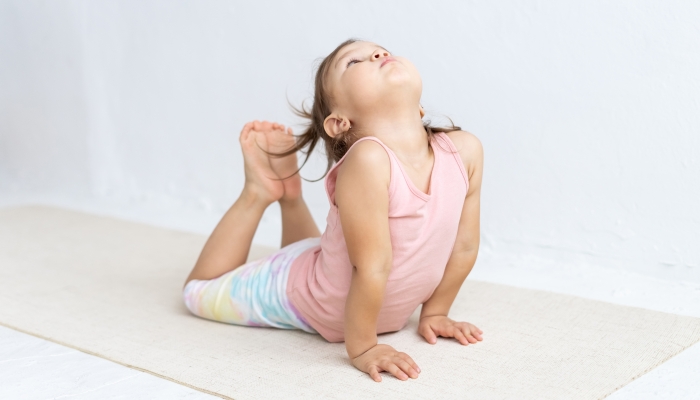
- Toddler yoga is very popular, with parents and kids alike enjoying yoga classes centered around this ancient discipline.
- Yoga is great for developing gross motor skills, improving coordination, and practicing balancing.
- The breathing techniques learned during kids’ yoga will be fantastic for helping your child calm down for years to come.
- You don’t have to spend a penny to introduce your toddler to yoga. You can learn together with the help of YouTube and library books.
Yoga is an ancient discipline combining physical postures, breathing techniques, and concentration. Rooted in Hinduism, Buddhism, and Jainism, this spiritual practice is now popular worldwide. Yoga is recommended by healthcare professionals as a great way to improve flexibility, reduce stress, and relax.
Yoga is fantastic for infants and toddlers; it helps them to develop their gross motor skills, balance, coordination, and concentration. It’s also a great way to calm down and refocus after a stimulating activity. The breathing techniques and slow movements teach your child awareness of their body and how they feel in the moment.
While the idea of your little one quietly engaging in a yoga session might seem impossible, many preschoolers love getting into some kids yoga. Plus, yoga for toddlers is a fun physical activity you can do at home.
Can Toddlers Do Yoga?
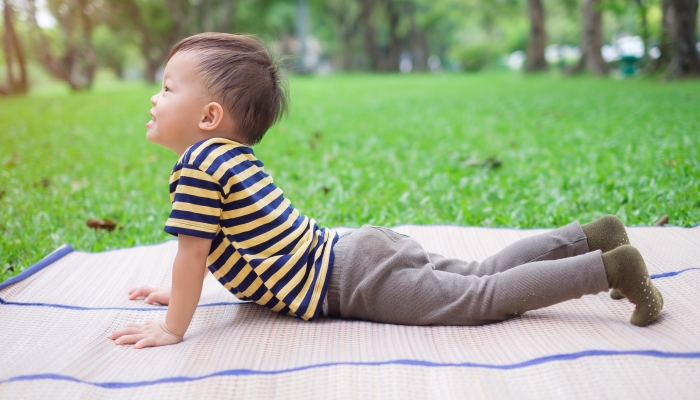
Yes, toddlers can do yoga. Toddler yoga classes are gaining popularity, with experts teaching yoga to curious toddlers. Kids yoga has many benefits, and if you can find a local toddler yoga class, you should go along and see what all the fuss is about.
Your toddler may not capture each pose perfectly, but toddler yoga is about so much more than perfect posture. Don’t forget toddler yoga is about creativity, physical movement, exploration, and fun.
8 Yoga Poses for Toddlers
Toddler yoga is so much fun; your child will love playing while doing yoga with you. Try some of these yoga poses for toddlers to get started:
1. Downward-facing dog pose
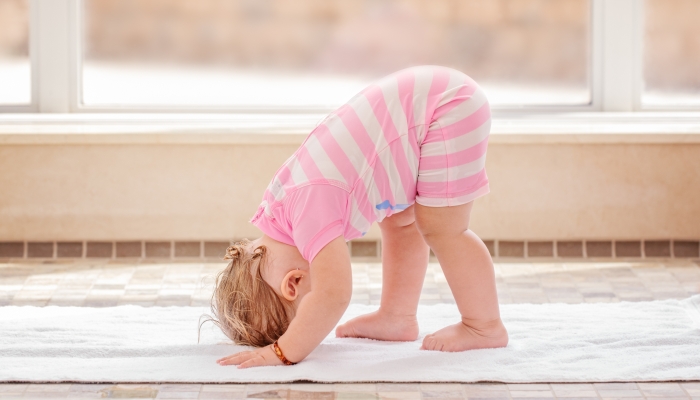
Downward-facing dog is probably one of the more famous toddler yoga poses, and it’s perfect for teaching yoga to toddlers because they’re forever getting into this position without prompting. Your toddler should have their feet firmly on the floor (ideally hip-width apart, but you can work on that over time) and their hands flat on the ground, looking downwards.
To make this position more fun, you can stand back to back to look at each other through your legs when in position. It’s perfect for kids who love animals. It goes without saying that barking is a must when doing the downward dog with a toddler, so play puppies with your toddler.
2. Cat pose
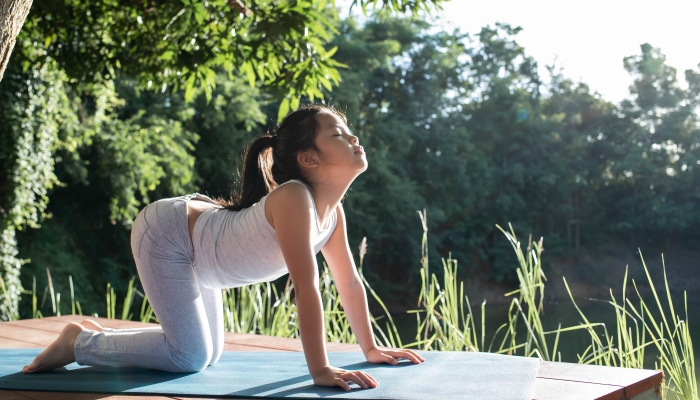
Another pose for the animal fans out there, the cat pose is a really easy pose to teach yoga to toddlers. To get into the cat pose, your toddler needs to be on all fours; then they should arch their back like an angry cat and keep their chin tucked in.
Hiss and meow your way through this pose for your toddler’s delight. Remember, you can play at being any feline animals you like—a lion, tiger, or a playful kitty.
3. Tree pose
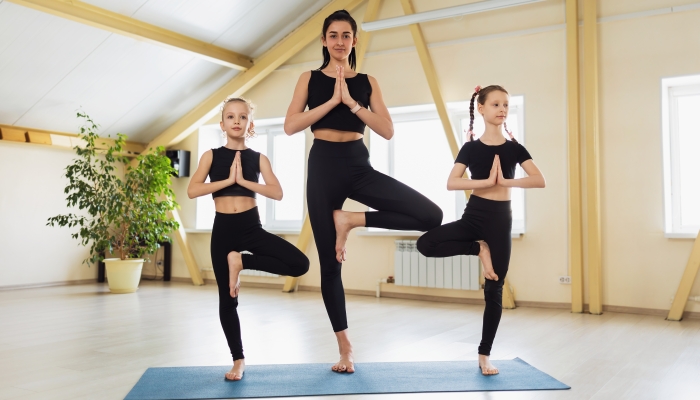
Tree pose is great for coordination and balance, so your toddler will love mastering this tricky pose. To begin, hold your toddler’s hand for stability while they lift one leg and rest their foot against the other leg while still standing. With some practice, your toddler will soon be able to lift their leg safely without holding your hand.
This is a perfect yoga pose for nature-loving toddlers because it will help them improve their balance, practice their coordination, and grow their confidence.
4. Triangle pose
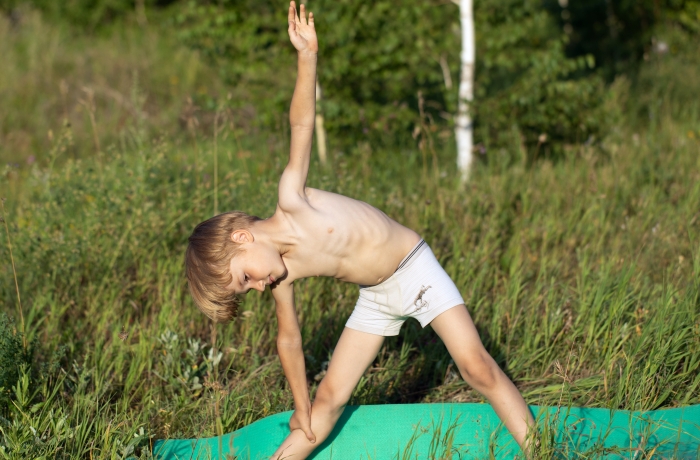
The triangle pose is fun for teaching yoga to toddlers because it involves bending, reaching, and balancing.
From a standing position, your toddler should step one foot back (leave this foot facing outwards) so their legs are open wide, hold their arms out parallel to the ground, then gently bend from the waist until they have one hand resting on their front knee, and the other reaching high in the air.
Your toddler will be developing their concentration skills as they focus hard on getting their arms in the correct position as they bend.
5. Standing forward bend pose
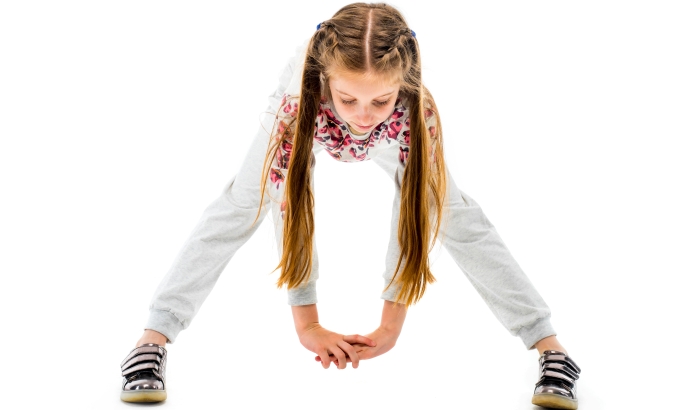
From standing, your toddler should bend forward at the waist so their hands are reaching for the floor. Once in position, they can sway their arms.
This is an excellent pose for toddlers, but don’t be surprised if they end up in a downward-facing dog after an overly enthusiastic bend. Remember, kids yoga is about having fun; it doesn’t matter whether they’re doing everything right. Even by doing it wrong, your kid is learning to move their body and have fun.
6. Squat pose
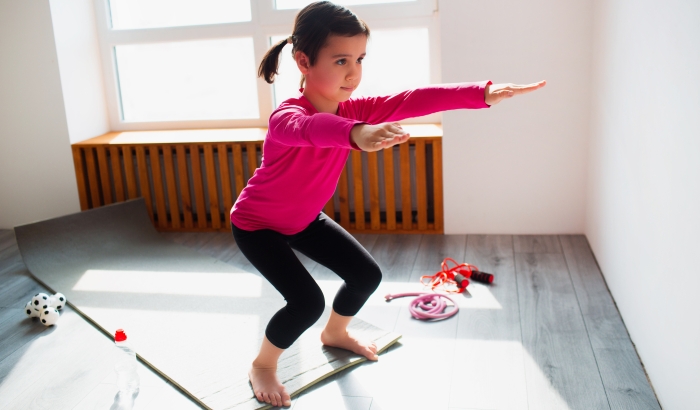
Your toddler is likely practicing this position regularly in everyday life, as it’s a popular resting position for curious kids during play. Simply squat down close to the ground. To make it fun, waddle forward in a squat position and quack like a duck.
7. Table top pose
The table top pose is a fun position for little ones. Get onto all fours and ensure your shoulders are lined up over your wrists and your hips are over your knees. Table top pose works really well with the cat pose. Slowly switch between cat pose and table top pose.
This combination is fantastic for sore backs, so it’ll be useful if you’ve got backache from lugging a heavy kid around all day.
8. Butterfly pose
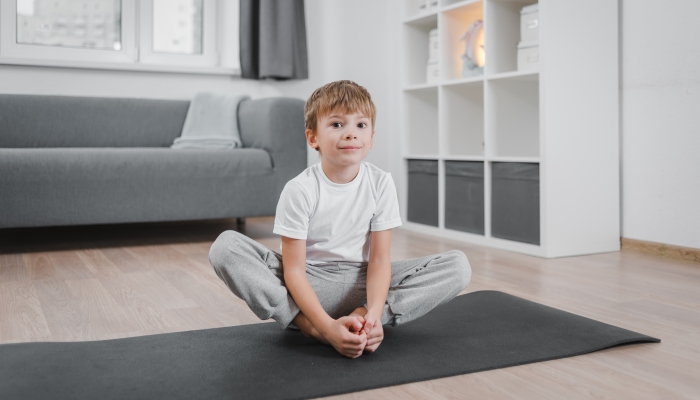
The butterfly pose is great for bug-loving children, and though many adults find this pose tricky, kids are usually great at it. Simply sit on your bottom with your legs bent and have the flats of your feet touch in front of you. Your legs should make a circle-ish shape on the floor.
For some extra fun and to improve flexibility, see if you can flutter like a butterfly by bouncing your knees up and down.
At What Age Can Kids Start Doing Yoga?
If you consider some of the most common yoga poses, they are often positions that toddlers find themselves in without help. Young kids love exploring their bodies and trying out different ways of moving. You often see them bending over, stretching up, or sitting down, exploring their limbs.
If you start practicing yoga next to your toddler, it’s highly likely they’ll start copying you and mimicking your poses. This is an easy way to introduce yoga to young children. If you want to attend a yoga class, find out what the minimum age requirement is. Most classes are suitable from ages 18 months and above.
What Are the Benefits of Yoga for Toddlers?
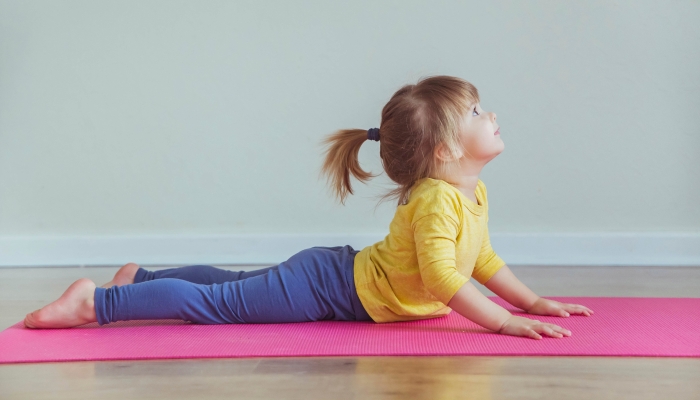
Ask any grown-up yoga fan, and they’ll be able to reel off a list of reasons why they love yoga. People love the quiet and calm that yoga brings and the way it strengthens your body and improves flexibility. While kids yoga may not be quite as quiet as adult yoga, it still boasts plenty of benefits for your toddler to enjoy.
Yoga is great for the development of gross motor skills. A 2021 study published in Frontiers Pediatrics11. Aleksić Veljković, A., Katanić, B., & Masanovic, B.. Effects of a 12-weeks yoga intervention on motor and cognitive abilities of preschool children. Frontiers in Pediatrics. 2021;9. https://doi.org/10.3389/fped.2021.799226 investigated the impacts of a 12-week yoga program on the motor and cognitive skills of preschoolers. The researchers concluded that: “Preschool children’s participation in the preschool yoga intervention significantly improved their motor abilities.”
The self-awareness that yoga naturally teaches has benefits for children’s social-emotional development as well. One study published in 2021 in the International Journal of Environmental Research and Public Health22. Sun, Y., Lamoreau, R., O’Connell, S., Horlick, R., & Bazzano, A. N.. Yoga and mindfulness interventions for preschool-aged children in educational settings: A systematic review. International Journal of Environmental Research and Public Health. 2021;18(11), 60919. https://doi.org/10.3390/ijerph18116091 found that yoga and mindfulness practices “constitute a promising strategy for social emotional development in early childhood settings.”
Yoga is great for building confidence, teaching your child how to safely move their body, and develop proprioception (understanding the location and movement of body parts). Teach your child body awareness in a fun and engaging way with yoga for little kids.
Another great thing about practicing yoga with your toddler is that it’s something you can do together. You can spend some quality time together moving your bodies and having fun. Yoga can become a bonding activity for you and your child, so you can unwind together whenever you want (or need) it.
Tips on How to Teach Yoga to Toddlers
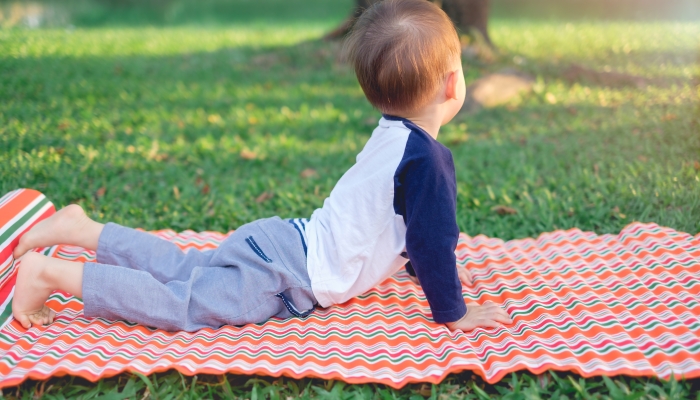
Teaching toddlers yoga isn’t exactly difficult, but these tips can help you get started on the right foot:
1. Set realistic expectations.
The most important thing you can do for your toddler is approach new activities with low expectations. Your toddler might not last the whole session; they may struggle to sit still and get distracted, but that’s fine.
Yoga isn’t something you’re going to teach in one session. It’s a lifelong practice your kids will learn by repetition.
2. Create an inviting yoga space.
Ideally, you should tidy away any clutter and remove any toys from your yoga space. Remove distractions so you and your child can focus on yoga. Lay some yoga mats on the floor. Your toddler will love having their own yoga mat to practice on.
3. See every space as a yoga mat.
Remember, though, you don’t need to be at home with your yoga mat to practice yoga. You can try out basic poses in your backyard (it’s a great outdoor activity for toddlers), burn off energy with yoga poses at the park, and calm down with yoga techniques after a public meltdown.
Yoga breathing techniques are perfect for self-regulation and, when coupled with mindfulness techniques for kids, can help to develop social-emotional learning.
4. Make it fun.
If you want your toddler to enjoy yoga, you need to make it a fun experience. Normal yoga rules don’t apply when it comes to yoga for toddlers. You want to encourage silliness, noise, and creativity.
It doesn’t matter whether your toddler is getting all the poses right; what matters is that they’re enjoying themselves. You can watch yoga videos together (YouTube has lots of fun options, like Cosmic Kids Yoga), use yoga pose cards to select poses, or rely on children’s yoga board books for inspiration. Look for creative ways to incorporate yoga into your daily life.
5. Tell a story.
Storytime yoga for children is really popular with adults and children alike. Young kids love listening to stories while moving their bodies, and parents love seeing their little ones do something active yet calming. You can introduce storytime yoga at home; all you need is a few yoga poses to include in your routine.
As your child grows older, they’ll be able to help come up with a narrative with you. They can shout out their favorite poses, and then together, you can come up with a story that includes all these poses.
Story yoga is the perfect way to develop your child’s imagination. It’s pretty simple to come up with something; remember, toddlers and preschoolers love repetition, so it doesn’t need to be a complicated story. With the poses above, you’ll have plenty of animal characters to include in your story.
References
- Aleksić Veljković, A., Katanić, B., & Masanovic, B. (2021). Effects of a 12-weeks yoga intervention on motor and cognitive abilities of preschool children. Frontiers in Pediatrics, 9. https://doi.org/10.3389/fped.2021.799226
- Sun, Y., Lamoreau, R., O’Connell, S., Horlick, R., & Bazzano, A. N. (2021). Yoga and mindfulness interventions for preschool-aged children in educational settings: A systematic review. International Journal of Environmental Research and Public Health, 18(11), 6091. https://doi.org/10.3390/ijerph18116091
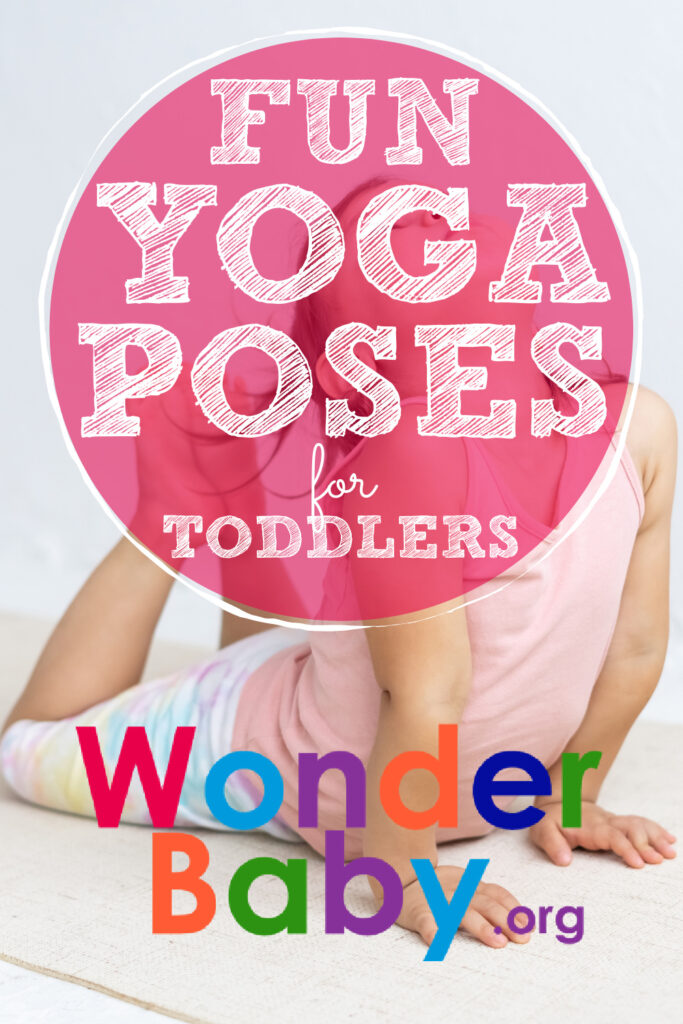
Related Posts

Braille and Literacy, Toys, Visual Impairment
24 Braille Toys for Kids Who are Blind
Everything from alphabet blocks to raised line coloring pages and activity books to puzzles to card and board games... and so much more! And it's all in braille ready for...

Holiday Crafts and Ideas
Should Parents Lie to Their Kids About Santa Claus?
Should parents lie about Santa? Find out how to balance trust, magic, and holiday traditions right here!

Holiday Crafts and Ideas, Special Needs
5 Tips for a Peaceful Thanksgiving with Your Child with Disabilities
Thanksgiving can be a joyful yet overwhelming holiday, especially for families with children who have sensory, motor, or dietary needs.